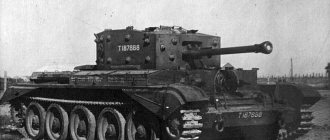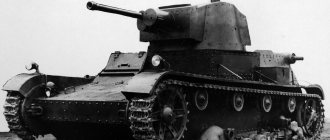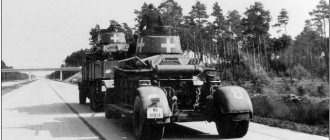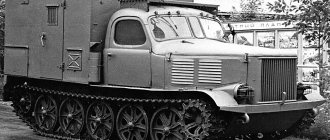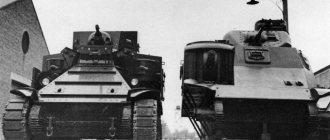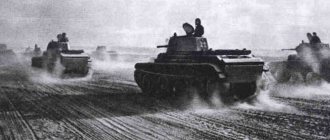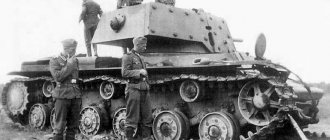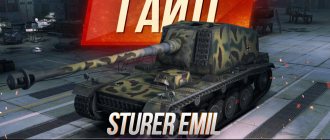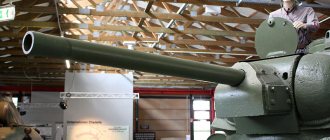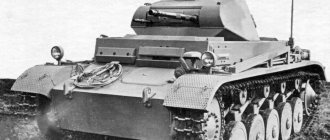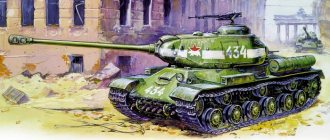Home » Real story » History of Wars » Yuri Pasholok. Tested in the USSR. Light infantry tank "Ha-Go"
History of Wars
byakin 04/09/2019 1120
15
in Favoritesin Favoritesfrom Favorites 8
The battles of July-August 1939 in the area of the Khalkhin Gol River became the first truly major battle for the Red Army in the 30s. The fighting in 1938 in the area of Lake Khasan was also quite fierce, but it could not be compared with Khalkhin Gol. At the same time, Khalkhin Gol became the first full test of strength for the Imperial Japanese Army. They had never encountered an enemy like the Red Army - this was especially true for Japanese tank units. During fierce battles, a number of Japanese armored vehicles were captured by the Red Army. One of these vehicles was the Ha-Go tank from the 4th Tank Regiment, which became the subject of careful study in the USSR. What impression did “Ha-Go” make on Soviet designers?
History of creation
The Type-92 and Type-94 light tanks, adopted by the Japanese Army in 1930, were rapidly becoming obsolete by the mid-1930s. Initially, it was planned to use combat vehicles to accompany cavalry, but in fact they were used as a means of supporting infantry. But the Japanese armored forces needed more advanced models and the command gave an order for the development of a new light tank.
The technical specifications presented by the General Staff spoke about the creation of a tank with cannon armament and reinforced armor. The project began in 1933. The prototype was temporarily given the working name “Shi-Ki” (屍鬼 – death to demons). A little later, the army designation “Ke-Go” was added to this name. The construction of the first experimental tank was carried out by Mitsubishi.
In addition to improved armor protection and enhanced weapons, another requirement was placed on the tank - high dynamics and mobility. Initially, design work went in two directions:
- Option with wheel-tracked chassis;
- Option only with tracked chassis.
Initially, priority was given to the wheeled-tracked model, but after the first tests it was decided to abandon it. The Japanese command concluded that this option was too low-tech and unreliable. In this situation, parallels can be drawn with the Soviet T-34 tank (two models were also presented to the leadership of the Communist Party of the USSR: the wheeled-tracked A-20 and the tracked A-32).
The first prototype was built in mid-summer 1933. The resulting tank weighed 500 kilograms more than the command required. Driving performance also let us down. The maximum speed did not exceed 40 km/h. In addition, the tank had difficulty overcoming 30-degree slopes. Another drawback was the tightness inside the car. Despite its externally large dimensions, a crew of 3 people could barely fit inside.
A critical drawback was noted to be weak armor.
It was originally planned that the tank would cover the infantry during the offensive, but the 12-mm armor did not allow for serious protection.
“Shi-ki” was sent for revision. The new model was ready for the winter of 1934. It was decided to conduct tests in conditions close to front-line ones. Several vehicles were sent to Northern Manchuria. This time the results were acceptable. The reduction in weight by half a ton had an effect. An additional factor was the diesel engine, which started in 20-degree frosts. The car was recommended for mass production.
However, improvement work continued. In almost six months, from July to November 1935, a new prototype was built. The turret underwent modifications (a commander's cupola and a rear machine gun were installed), the stamped drive and guide wheels were replaced with cast ones, and two headlights were added. The car became the standard for the series. The tank was renamed from “Shi-ki” to “Ha-go” (“2595”).
Production[edit]
Ha-Go tanks were mass-produced from 1936 to 1943, but Mitsubishi factories continued to produce tanks of this model, including the Ke-Nu variant, in small quantities until the very end of the war. In addition to Mitsubishi itself, Ha-Go was produced by Niigata Tekkosho, Kobe Seikosho, Dowa Jidosha and Kokura Arsenal (Kokura Rikugun Joheisho). From 1935 to 1938, the tank was produced in small series; mass production began only in 1939, after the end of active hostilities in China. Despite the appearance in 1938 of a much more advanced light tank, the Ke-Ni, it was never able to replace the Ha-Go on assembly lines, entering production only in 1942 and being produced in small batches until the end of the war. This situation was caused by the lack of desire on the part of the army command to equip the troops with the best available, since the reliability of the Ha-Go did not raise any complaints from the troops that used it, as well as the reluctance to have several types of light tanks in service.
Data on the number of cars produced vary greatly. According to Japanese sources, the production amounted to 2,378 vehicles, while European works, mainly based on post-war American sources, give a figure of 1,161 tanks produced. Despite the official withdrawal from service in 1943, the Ha-Go was actually used until the surrender of Japan, including due to the extreme decrease in combat value by 1944, as training vehicles.
Design
The Ha-go tank was distinguished by the lack of original design solutions. The armor is riveted. It was assembled from rolled armor steel sheets on the main frame.
The control compartment was located in the bow of the tank.
It contained 2 tank crew members: a driver and a machine gunner. The location of the mechanical drive was shifted to the right of the center of the tank. The machine gunner was located to the left, in a specially placed forward wheelhouse. A 6.5 mm machine gun, which had several fixed positions, was also mounted there.
5x optics were used as a sighting device. The control compartment was protected by 12 mm armor plates.
In the central part of the hull there was a fighting compartment (CS). The tank commander was there, he was aiming and loading the main gun. On the sides of the ammunition there were shelves for stowing ammunition. The turret, which had 12 mm circular armor, was installed on the roof of the fighting compartment and had a conical shape.
For better visibility, viewing slits and a commander's cupola were used.
In addition, the crew entered the tank only through hatches on the turret located on the side and top.
A 37 mm caliber gun, Type-94, is installed in the front of the turret. It had a barrel length of 37 calibers (About 1370 mm) and a telescopic sight. The designers managed to achieve good vertical aiming angles: -20 down and +24 up.
The gun could move in a horizontal plane without rotating the turret by 10 degrees relative to the central axis. The caliber projectile fired from this gun had an initial flight speed of 575 m/s and was capable of penetrating a 35-mm sheet of armored steel at a distance of about 300 meters. The turret had a machine gun located on the rear armor plate.
A 120 horsepower Mitsubishi diesel engine was installed in the rear of the Ha-go, closer to the starboard side. Behind it there were cooling system fans, a tank for fuel and oil, and an oil cooler. An additional fuel tank was located to the left of the engine. The exhaust pipe was led out to the starboard side, where it was secured with brackets. Access to the power plant was through a hatch in the rear inclined armor plate.
As in German tanks, the transmission here was located in the bow. Power from the engine was transmitted via a driveshaft passing through the fighting compartment.
The gearbox had 4 stages and was equipped with a gearbox.
The chassis of the tank had a Hara type suspension:
- Eight rubberized road wheels;
- Four trolleys combining rollers in pairs;
- Two support rollers;
- A pair of drive wheels that had a lantern engagement;
- Two rear guide wheels;
- The tank's caterpillar consisted of 97 tracks with a width of 25 cm and a pitch of 9.5 cm.
The fighting compartment and control compartment were connected by an intercom designed for communication between crew members.
Communication with other tanks was carried out by signal flags. There are two headlights installed on the upper front frontal part.
Organizational and staffing structure[edit]
In the second half of the 1930s, according to the staffing table, the tank regiment included:
- Headquarters company with tank platoon (5 Type 89 medium tanks)
- Four companies of medium tanks with three platoons each (45 tanks)
- Reserve company of light tanks (15 tanks)
- Reconnaissance platoon (5 Type 94 small tanks)
In practice, due to the shortage of medium tanks, there were both regiments armed with Type 89 tanks and regiments in which Ha-Go tanks served as medium tanks. The organizational structure of tank units was constantly changing; by 1941, a company of medium tanks began to consist of three platoons of medium tanks of 5 tanks each and a platoon of light tanks of 4 vehicles. In practice, the composition of the regiment could be very diverse, since the staffing schedule was never met. All Japanese tank regiments were understaffed to varying degrees, and there were regiments that were re-equipped with new Chi-Ha medium tanks, as well as those that retained old Type 89 vehicles or fully equipped Ha-Go regiments.
In the Ha-Go cavalry brigades, they were part of light tank battalions, which included two companies of light tanks (33 tanks) and a reserve tank platoon of 6 tanks. Also, one company of tanks (9 vehicles) was included in the infantry divisions and marine divisions.
Specifications
Dimensions, weight, reservation:
- Length, width, height, ground clearance /cm/ – 437/206/228/40;
- Weight – 6500 kg.
| Part | Reservation, mm | |||
| Location | Top | Middle | Bottom | |
| Frame | Forehead | 12 | 9 | 12 |
| Board | 12 | — | 12 | |
| Stern | 6 | — | 10 | |
| Tower | Forehead | 12 | — | — |
| Board | 12 | — | — | |
| Stern | 12 | — | — | |
| Tower roof | 9 | — | — | |
| Housing roof | 9 | — | — | |
| Bottom | 9 | — | — | |
| Cannon mask | 12 | — | — | |
Mobility:
- Air-cooled in-line diesel engine. 6 cylinder;
- Power plant power 120 l/s;
- Maximum speed on hard surfaces 45 km/h;
- Maximum speed over rough terrain 28 km/h;
- Cruising range: over rough terrain – 210 km, on highway – 250;
Modifications and developments based on the tank
The light tank Type-95 “Ha-Go” initially turned out to be quite successful, but still required a number of improvements. In particular, after testing in the steppes of Mongolia, the designers strengthened the suspension by adding one roller to each pair of bogies.
The factories that produced the Type-95 modernized it at their own discretion.
Serial models:
| Name | Description |
| “Ke-Nu”, Type-4 | The small-scale modification was the “Ha-Go” with a large turret from the “Chi-Ha” installed. This turret had space for both a commander and a gunner. The main goal is to increase firepower, which was facilitated by the 57 mm Type-97 cannon. |
| “Ka-Mi”, Type-2 | Floating version of “Ha-Go”. About 150 copies were produced. |
| “So-To” | Anti-tank self-propelled gun equipped with a 37 mm Type-94 gun. Produced since 1940 in small quantities. Instead of a tower there was a wheelhouse with a carriage for a gun. Additionally equipped with anti-cumulative screens. |
Various prototypes:
| Name | Description |
| “Ke-ri”, Type-2 | Developed in 1942. The main goal was an attempt to strengthen the weapons of the conventional “Ha-go”. According to the project, the 37-mm gun was replaced with a 57-mm short-barreled gun of the early Chi-Has. The model was abandoned due to the fact that the breech took up a lot of space inside the turret and the commander could not perform his functions. |
| “Ka-Ho”, Type-99 | An unsuccessful attempt to create an amphibious tank. Didn't go into the series. |
| “Ha-go” with the tower “Ke-ni” | A two-man turret with a Type-98 was installed on the linear tank. This variation did not provide any serious advantages and the car was not put into production. |
| “Ho-To”, Type-5 | Self-propelled installation. Instead of a tower, a wheelhouse was mounted, with armor plates 8 mm thick. It was planned to install a 120 mm Type-38 howitzer. The vehicle could not be put into production due to production difficulties and the cramped fighting compartment. |
| “Ho-Ru”, Type-5 | Prototype anti-tank self-propelled gun. A Type-1 gun of 47 mm caliber was installed. The tower was removed. We installed a wheelhouse that was open at the rear. The chassis has been redesigned: the tracks and the way the drive wheel engages have been expanded. |
According to official data, for the entire period from 1935 to 1943, 2348 Type-95 “Ha-go” tanks were produced.
During its operation, “Ha-go” took part in many land battles in all theaters of war in which Japan actively participated. This includes the seizure of the islands of Oceania and operations in China and Mongolia.
And although the tank did not have outstanding characteristics, it was used until the very end of the war. Even when it was already technically outdated, Japanese crews went into battle with it against more advanced Shermans, without hope of success.
Content
- 1 History of creation
- 2 Production
- 3 Design description 3.1 Hull and armor
- 3.2 Armament
- 3.3 Engine and transmission
- 3.4 Chassis
- 4.1 Ha-Go based vehicles
- 6.1 China
- 7.1 Construction
Combat use[edit]
China[edit]
The first Ha-Go tanks entered service with the 4th Tank Regiment of the Mixed Mechanized Brigade of the Kwantung Army back in 1935. After testing in February 1935 tank companies for the ability to conduct combat operations in winter conditions, which gave unsatisfactory results, all available armored forces were transferred to central China. In the battles against the small and poorly organized Chinese armored vehicles in 1937 - 1938, the small Ha-Go tanks, like the rest of the armored forces, did not prove themselves to be anything special.
Mongolia[edit]
The first serious combat test for the Ha-Go tanks was the clash between the Kwantung Army and Soviet troops near the Khalkhin Gol River in 1939. The mechanized brigade, consisting of the 3rd and 4th tank regiments, had 35 Ha-Go tanks, organized into three line and one reserve company as part of the 4th tank regiment.
"Ha-Go", captured by Soviet troops after the battles at Khalkhin Gol.
One “Ha-Go” was lost on June 30 from the fire of a 45-mm anti-tank gun while still on the way to the site of hostilities. On the evening of July 2, the 3rd Tank Regiment, with the support of the 4th Tank Regiment, launched an offensive against Soviet positions. Tank units advanced without infantry support and clear instructions, but focal Soviet defenses in the attack area initially made it possible to break through quickly and with few losses. This was the end of the successes of the Japanese armored forces; already on July 3, during an attack on Soviet units on the eastern bank of the river, Japanese tanks were met with artillery fire, BT-5 tanks and BA-10 armored vehicles, which led to the complete defeat of the 3rd tank regiment and the loss of 41 vehicles out of 44 brought into battle, including several Ha-Go, one of which was captured by Soviet troops. On the Red Army side, losses amounted to only three BT-5s. The very first clashes showed the low anti-tank qualities of Japanese tank guns, which allowed BTs armed with more powerful and long-range guns to shoot Japanese vehicles from long distances.
Malaya and Singapore[edit]
The Japanese attack on Singapore involved 85 Ha-Go tanks belonging to the 1st, 6th and 14th Tank Regiments of the Japanese 25th Army. It was in this operation that the specificity of the training and organization of Japanese tank forces was most clearly demonstrated. From the north, on the land side, Singapore, as the British believed, was protected by mountains and dense jungle from a serious attack, especially using tanks, but the Japanese had been exploring the possibility of fighting tank units in the jungle since the late 1930s. On December 8, 1941, Japanese troops landed on the coast of the Malay Peninsula near Malacca, and soon began their advance towards Singapore. Although the rough terrain made it difficult for the vehicles to operate, the tanks, not only the light Ha-Go, Te-Ke and Type 94, but even the medium Chi-Ha, accompanied by bicycle infantry, confidently advanced in columns along rare roads . At the same time, tanks were also used as a vehicle for cargo that infantrymen could not carry.
Singapore had powerful fortifications, but they were all facing the sea. The Japanese troops struck from the land, taking the British by surprise. Tank losses were insignificant due to Japanese air supremacy and the enemy's lack of anti-tank weapons. The most intense tank battles took place on January 7, 1942, but in general the small number of British tanks, represented mainly by tankettes, could not provide serious resistance. Already on February 15, British troops capitulated. Overall, the attack on Singapore was one of the most effective operations of Japanese armored forces.
Burma[edit]
To support the Japanese offensive in Burma, in April 1942, the 1st, 2nd and 14th tank regiments, armed with Ha-Go tanks, were deployed. In Burma, the opponents of Japanese tanks were the American-made M3 Stuart, the British Mk VI small tanks and the Chinese Soviet-made T-26. Tank battles proper, despite the presence of tanks on both sides, were very rare, but even these episodic skirmishes showed the weakness of the Ha-Go's weapons, even compared to the long-barreled 37-mm guns of the Stuarts, and the armor, which was vulnerable at close ranges even for the fire of heavy machine guns Mk VI. Basically, tanks were used by the command to support infantry both in the offensive and in defense.
Pacific Islands[edit]
Ha-Go in battles on Tarawa Atoll.
52 Ha-Go tanks formed the main force of the 14th Army during the invasion of the Philippines and were actively used during combat operations from the first clashes on December 22, 1941 until the last, on April 7, 1942. Tanks usually led infantry attacks, sometimes making quick dashes to objectives already captured by infantry in order to finally break enemy resistance. On December 22, the first tank battle in this area of military operations took place, during which the “Ha-Go” of the 4th Tank Regiment defeated the opposing M3 Stewarts of the 192nd Independent Tank Battalion of the US Army. Armored forces played a large role in the capture of the Philippines, largely due to the Americans' lack of anti-tank weapons.
In June 1942, with the participation of Ha-Go tanks, Japanese troops landed on the Aleutian Islands. A small number of Ha-Gos took part in the battles for the island of Guadalcanal, where they suffered heavy losses in October 1942.
Several tanks were landed from the sea during the Japanese assault on the city of Port Moresby in New Guinea. Due to tropical rainfall, the tanks became stuck in the sand, were abandoned or knocked out, and the infantry was destroyed by superior Australian forces.
The 14 Ha-Go tanks of the 6th and 7th Marine Special Amphibious Units took part in the defense of the Gilbert Islands in November 1943, where they first encountered the new American M4 Sherman tanks. One "Ha-Go", having entered into battle with a "Sherman", managed to initially jam the latter's turret with a shell (according to other sources, damage the gun) of the latter, but the "Sherman", taking advantage of its fourfold advantage in mass, simply rammed the Japanese tank and took it out of building. Taking advantage of their almost impenetrable armor for the Ha-Go cannon, the Shermans usually shot at Japanese armored vehicles with impunity. After the capture of the Gilbert Islands by the Americans, in February 1944, 9 Ha-Gos took part in the defense of the Marshall Islands, where they were quickly destroyed by Sherman guns.
The appearance of the Shermans on the battlefield immediately made the Ha-Go hopelessly obsolete, as did the rest of the Japanese tanks, which by 1944 began to invariably suffer heavy losses in almost any clash with much more advanced enemy equipment.
Ha-Go, shot down by Australian troops in New Guinea.
Several Ha-Gos in the 36th Infantry Division's tank group took part in the defense of New Guinea in 1944, but tank use on both sides was rather sluggish. The only tank battle took place on July 3, when two Ha-Gos guarding the Wiske airfield engaged two American LVT amphibious tanks, soon destroying one of them and putting the other to flight.
The Mariana Islands, which were an important strategic link in Japan's defense system, concentrated significant armored forces by Japanese standards of the 9th Tank Regiment, including 58 Ha-Go tanks. Most of them were lost on June 15-17 in desperate but ineffective Japanese counterattacks against American troops landing on the island of Saipan. By the end of June, the Japanese had lost most of their tanks, practically useless against the numerous Shermans and M5 Stuarts supported by anti-tank artillery fire.
"Ha-Go" took part in the defense of Peleliu Island on September 15-16, where 15 or 16 vehicles of this type from a tank company of the 14th Infantry Division launched a counterattack against the landing American forces. The tanks moved with the landing force on their armor at maximum speed, but in a quick and fierce battle they, along with the landing party, were completely destroyed by the Americans, who fired furiously with high-explosive shells from Sherman guns and light howitzers.
About 20 "Ha-Go" were used by the Japanese in the defense of the Philippines in October 1944 - March 1945, where almost all of them were lost in battles against an enemy with overwhelming both quantitative and qualitative superiority. Some of the last surviving vehicles in the Philippines were used in a suicide attack, when two tanks, the Ha-Go and the Chi-Ha, loaded with explosives, rammed a column of Shermans at full speed.
"Ha-Go", captured by American troops on the island of Io.
The last battles for Japanese tanks in the Pacific were the battles for the islands of Iwo Jima and Okinawa in 1945. The 26th Tank Regiment, which included 17 Ha-Go tanks, was stationed on Iwo Jima. Most of the Japanese tanks were used as stationary dug-in firing points in an unsuccessful attempt to make them at least somewhat effective against superior American forces. The few tank counterattacks against the landing Americans in February 1945 were easily repelled by Shermans and bazooka fire. The last battles for tanks of this type were the battle for the island of Shumshu (Simushu).
According to a similar scenario, events developed in Okinawa, where 13 “Ha-Go” 27th Tank Regiment took part in the battles. Most of the Japanese tanks were destroyed in counterattacks by May 1945, but subsequently, when the fighting acquired a positional character, tanks almost did not take part in the battles.
Manchuria, 1945[edit]
During the Red Army's offensive in Manchuria in August 1945, numerous Japanese tanks actually did not show themselves at all and were mostly captured by Soviet troops right in the parks. Only 25 “Ha-Go” of the 11th tank regiment, located on the Shumshu and Paramushir islands of the Kuril ridge, had a chance to take part in active hostilities.
Post-war use[edit]
Most of the Japanese tanks captured by Soviet troops in Manchuria, including the Ha-Go, were transferred to the People's Liberation Army of China, with which they took part in the Third Chinese Civil War. On the other hand, no less number of tanks captured by the Americans were transferred to Chiang Kai-shek's army. In addition, a small number of Ha-Go captured in Burma were subsequently used by French troops in Indochina.
Material of manufacture
The classic material for making a blade is considered to be high-carbon steel, forged and heat-treated using a special technology.
There are samples of weapons made from Damascus steels or alloy steels produced by the Obukhov plant. Such blades were produced until the end of the 19th century and were produced in single copies or in small series. However, due to the tradition of ordering personal edged weapons from craftsmen, damask sabers were quite often found among officers of the Russian army and Cossack troops.
A characteristic feature of all blades is a bend with a slight curvature and the presence of double-sided sharpening near the tip. An exception may be products from Central Asia, which have a greater curvature of the blade.
There are fullers on both side surfaces of the blade. In the case of using several fullers, one of them has a larger width and is located next to the sharpened edge of the blade. By using several fullers, the rigidity of the blade increased, since the spaces between them acted as reinforcement ribs.
Links
World of Tanks Resources
- Tank science
- Thread on the official forum
- Recordings of battles on the Type 97 Chi-Ha
On the Internet
- Chi-Ha // Wikipedia
- Review of Type 97 Chi-Ha // Mirtankov
Japanese technology
| Light tanks | I Renault Otsu • II Type 95 Ha-Go • II Type 97 Te-Ke • III Type 97 Chi-Ha • III Type 98 Ke-Ni • IV Type 5 Ke-Ho |
| Medium tanks | II Chi-Ni • II Type 89 I-Go/Chi-Ro • IV Type 1 Chi-He • V Type 3 Chi-Nu • V Type 3 Chi-Nu Kai • VI Type 4 Chi-To • VII Type 5 Chi- Ri • VIII STA-1 • VIII STA-2 • IX Type 61 • X STB-1 |
| Heavy tanks | III Type 91 Heavy • IV Type 95 Heavy • V OI Experimental • VI Heavy Tank No. VI • VI OI • VII O-Ni • VIII O-Ho • IX Type 4 Heavy • X Type 5 Heavy |
Medium tanks
| USSR technology | III T-29 • IV A-32 • IV T-28E with F-30 • IV T-28 • V Matilda IV • V T-34 shielded • V T-34 • VI A-43 • VI T-34-85M • VI T-34-85 Rudy • VI M4-A2 Sherman Lozy • VI T-34-85 • VII A-44 • VII KV-13 • VII T-43 • VIII Object 416 • VIII T-54 first sample • VIII T-44-100 (B) • VIII T-44-100 (P) • VIII T-44-100 (U) • VIII STG • VIII STG Guardsman • VIII T-44 • IX Object 430 Option II • IX Object 430 • IX T-54 • X Object 140 • X Object 907 • X T-22 sr. • X K-91 • X Object 430U • X T-62A |
| German technology | III Großtraktor – Krupp • III Pz.Kpfw. IV Ausf. A • III Pz.Kpfw. S35 739 (f) • IV Pz.Kpfw. III Ausf. J • IV Pz.Kpfw. IV Ausf. D • IV VK 20.01 (D) • V Pz.Kpfw. III Ausf. K • V Turán III prototípus • V Pz.Kpfw. III/IV • V Pz.Kpfw. IV hydrostat. • V Pz.Kpfw. V/IV • V Pz.Kpfw. V/IV Alpha • V Pz.Kpfw. IV Ausf. H • V Pz.Kpfw. T 25 • V VK 30.01 (H) • VI Pz.Kpfw. IV Schmalturm • VI VK 30.01 (D) • VI VK 30.02 (M) • VII Panther/M10 • VII Panther • VII VK 30.02 (D) • VIII Panther mit 8.8 cm L/71 • VIII Schwarzpanzer 58 • VIII Panzer 58 Mutz • VIII M48A2 Räumpanzer • VIII Indien-Panzer • VIII Panther II • IX E 50 • IX T 55A • IX Kampfpanzer 50 t • IX Leopard Prototyp A • X E 50 Ausf. M • X Leopard 1 |
| US technology | II T2 Medium Tank • III M2 Medium Tank • IV T6 Medium • IV M3 Lee • V M4 Improved • V M4A2E4 Sherman • V M4A1 Sherman • V Ram II • VI M4A3E8 Fury • VI M4A3E8 Thunderbolt VII • VI M4A3E8 Sherman • VI M4A3E2 Sherman Jumbo • VII T26E3 Eagle 7 • VII T20 • VII T23E3 • VIII T25 Pilot Number 1 • VIII TL-1 LPC • VIII M46 Patton KR M26 Pershing VIII T26E4 SuperPershing • VIII T69 • VIII T95E2 • IX M46 Patton • X M48A5 Patton • X M60 • X T95E6 |
| French technology | III D2 • III Somua S35 • IV SARL 42 • V Renault G1 • VI Bretagne Panther • VIII Bat.-Châtillon Bourrasque • VIII Lorraine 40 t • VIII AMX Chasseur de chars • VIII M4A1 Revalorisé • IX AMX 30 1er prototype • IX Char Futur 4 • IX Bat.-Châtillon 25 t AP • X Bat.-Châtillon 25 t • X AMX 30 B |
| UK technology | I Vickers Medium Mk. I • II Vickers Medium Mk. II • III Vickers Medium Mk. III • IV Matilda • IV Grant • IV AC 1 Sentinel • V Cavalier • V Sherman III • V Matilda Black Prince • VI Sherman Firefly • VI Cromwell • VI AC 4 Experimental • VI Cromwell B • VI Sherman VC Firefly • VII Comet • VIII Centurion Mk. I • VIII FV4202 • VIII Chieftain/T95 • VIII Centurion Mk. 5/1 RAAC • VIII Chimera • IX Centurion Mk. 7/1 • X Centurion Action X |
| Chinese technology | V Type T-34 • VI Type 58 • VII T-34-1 • VIII Type 59 • VIII T-34-2 • VIII T-34-3 • VIII 59-Patton • VIII Type 59 G • IX WZ-120 • X • X 121B |
| Japanese technology | II Chi-Ni • II Type 89 I-Go/Chi-Ro • IV Type 1 Chi-He • V Type 3 Chi-Nu • V Type 3 Chi-Nu Kai • VI Type 4 Chi-To • VII Type 5 Chi- Ri • VIII STA-1 • VIII STA-2 • IX Type 61 • X STB-1 |
| Technology of Czechoslovakia | IV ST vz. 39 • V Škoda T 24 • VI Škoda T 40 • VI Škoda T 25 • VII Konštrukta T-34/100 • VIII TVP VTU Koncept • VIII Škoda T 27 • IX Škoda T 50 • X TVP T 50/51 |
| Swedish technology | IV Lago • V Strv m/42 • VI Strv m/42-57 Alt A.2 • VI Strv 74 • VII Leo • VIII Strv 81 • VIII Primo Victoria • VIII Lansen C • VIII UDES 14 Alt 5 • IX UDES 16 • X UDES 15/16 |
| Equipment Poland | V 25TP KSUST II • VI Pudel • VI 40TP Habicha • VI T-34-85 Rudy |
| Italian technology | II M14/41 • III M15/42 • IV P26/40 • V P.43 • VI P.43 bis • VII P.43 ter • VIII Progetto M35 mod. 46 • VIII P.44 Pantera • IX Prototipo Standard B • X Progetto M40 mod. 65 |
Surviving copies[edit]
As of 1999, 15 Ha-Go tanks and two Ke-Nu tanks were preserved in museums.
- Russia: Shumshu Island, Kuril Islands (2 “Ha-Go”).
- territory of the Sakhalin State Museum of Local Lore in the city of Yuzhno-Sakhalinsk
- Museum of armored weapons and equipment in Kubinka near Moscow (“Ha-Go” and the only surviving “Ke-Nu”).
- Victory Park on Poklonnaya Hill in Moscow (“Ke-Nu”, taken from the Kuril Islands).
- State Military Technical Museum in Chernogolovka (“Ha-Go” in running condition from Shumshu Island).
- Aberdeen Proving Ground Museum.
In addition, several dozen, mostly battle-damaged, “Ha-Go” have survived on the Pacific islands: Pohnpei, Peleliu, Babeldaob and Chuuk of the Republic of Palau, Tarawa Atoll, the islands of Guam, Saipan, Wake and New Guinea, as well as the island of Kar -Nicobar in the Indian Ocean.
Car evaluation[edit]
Construction[edit]
The Ha-Go was a fairly typical light tank for the mid-1930s, although it was noticeably lighter than cavalry tanks from other countries. It was also quite typical for the Japanese school of tank building during World War II. The Ha-Go, like most Japanese tanks, was easy to manufacture, master, and repair, earning a reputation as a reliable and unpretentious vehicle. However, the simplicity of the design, which largely ensured their reliability, in many ways reached the point of primitiveness.
All observation of the battlefield was carried out exclusively through viewing slits; there were no other observation devices. The visibility was unsatisfactory, especially for the driver, whose field of vision with the hatch closed was limited to a narrow sector in front, so he had to rely mainly on the instructions of the commander. At the same time, open and rather wide viewing slits often caused the crew to be hit by lead splashes and even random bullets. The abundance of hatches and removable armor parts made it easier to maintain and repair the tank, but reduced the already low armor resistance of the hull and turret, and rivets and bolts often became additional damaging elements when hit by shells. There was no effective protection for the crew from ricocheting bullets and shrapnel.
The spaced installation of the cannon and machine gun in the turret also turned out to be unsuccessful, which complicated the already difficult work of the commander, who was also forced to deal with servicing the cannon. The lack of radio stations in most tanks greatly complicated the actions of even small units.
Combat use[edit]
The main problem of the Ha-Go was its weak armor, which provided full protection only from rifle-caliber bullets, while even the 12.7-mm Browning M2 machine gun could penetrate it with an armor-piercing bullet from a distance of 500 m. The weakness of the tank’s armor protection led to the fact that the success The use of "Ha-Go" was most often determined by the presence of anti-tank weapons on the enemy's side. The tank’s second problem was its insufficient armament, which at the beginning of the war was inferior even to guns of similar caliber on enemy tanks, and was almost useless against the 45-mm sloping frontal armor of the Stuarts, not to mention the Shermans.
In the role of an infantry tank, more precisely, because of its armor, rather a light field gun on a self-propelled chassis, the Ha-Go was used with somewhat greater success, but the high-explosive 37-mm projectile, despite the powerful high-explosive effect for its caliber, still was insufficient even to fight field fortifications.
In the first half of the war, the main danger to the Ha-Go was the American M3 anti-tank gun, as well as its tank version, which became the main reason for the loss of tanks by the Japanese. Since 1943, they were supplemented by fire from 75-mm Sherman tank guns, and from 1944, losses from Bazooka RPG fire.
While the M3 Stuart remained the best allied tank in the Pacific Ocean, the Ha-Go could still somehow fight them, although the American tank had much better armor, which protected well from the fire of weak Japanese guns. But the new M4 Sherman tanks, which appeared in 1943, turned out to be practically invulnerable to Ha-Go guns, even at extremely short distances.
Analogs[edit]
By the time of its creation, the Ha-Go was approximately at the level of tanks from other countries in its class, such as the PzKpfw II or British cruiser tanks, albeit somewhat inferior to the latter in armament, but by the end of the 1930s light tanks had grown significantly in mass , superior to the Ha-Go in armament, and often in armor, which the American M2 and M3 Stuart was able to protect even from small-caliber projectiles
Gallery[edit]
- The first prototype of the Ha-Go tank after the second stage of modifications, 1934.
- Ha-Go during sea trials.
- Ha-Go on parade in Singapore, 1942
- Ha-Go in a Japanese Army tank park, presumably China, late 1930s.
- Ha-Go light tanks on Marcus Island, 1944.
- Ha-Go at the US Army Ordance Museum, Aberdeen.
- Ha Go in Bangkok.
- Museum Ha-Go in Honolulu.
- Ha-Go at the Indiana Military Museum, Vincennes.
- Ha-Go on display at the Central Museum of the Great Patriotic War.
- Soviet tank crews inspect a captured Type 95 Ha-Go tank from the 4th Tank Regiment of the Kwantung Army. The vehicle was captured in battle on July 3, 1939. In the winter of 1939–1940, this tank was tested at a training ground in Kubinka near Moscow.
- One of the Type 95 Ha-Gos that are on a "tank farm" in Micronesia.
